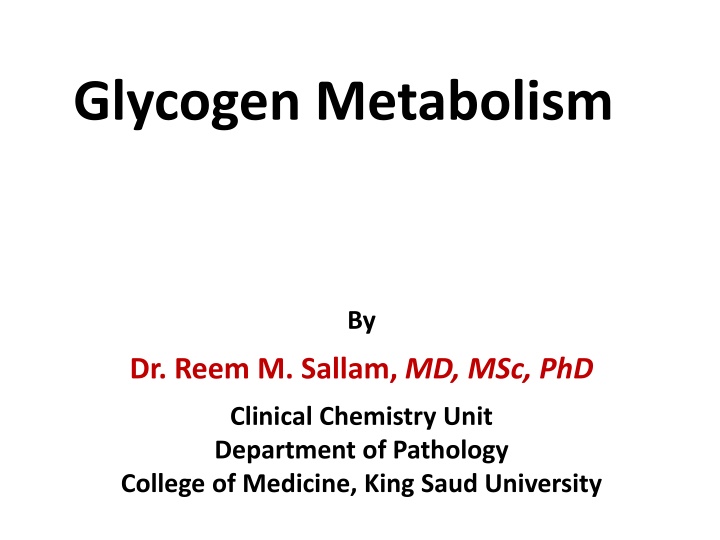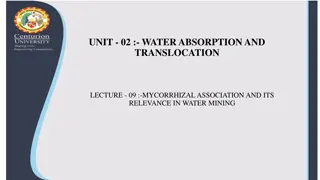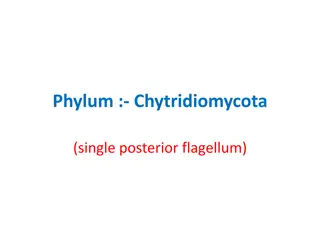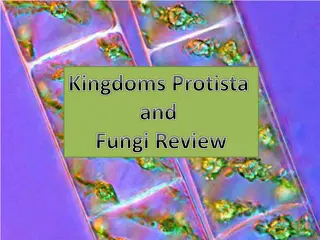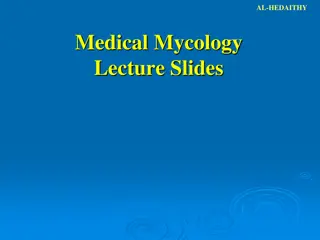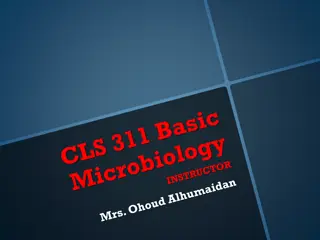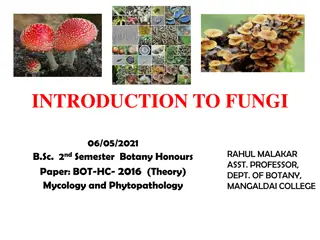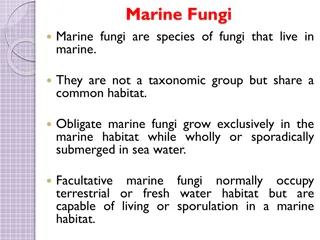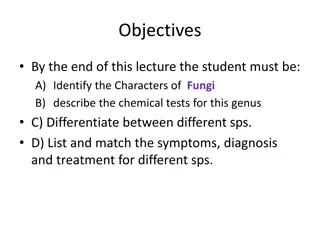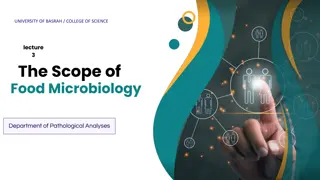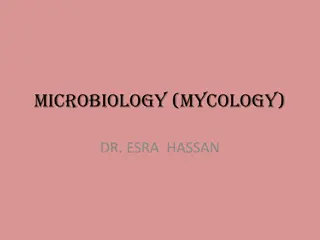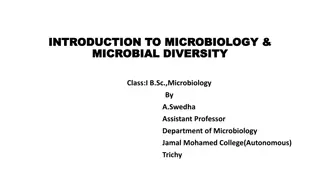Introduction to Fungi in Microbiology
Fungi are eukaryotic organisms that encompass yeasts, molds, and mushrooms. This article delves into the characteristics of Division Eumycota, exploring parasitic, saprophytic, and symbiotic fungi. It details their modes of nutrition, cell wall composition, and types of interactions with other organisms. The classification of Eumycota into various classes is also discussed, shedding light on the diverse world of true fungi.
Uploaded on Apr 16, 2025 | 1 Views
Download Presentation

Please find below an Image/Link to download the presentation.
The content on the website is provided AS IS for your information and personal use only. It may not be sold, licensed, or shared on other websites without obtaining consent from the author.If you encounter any issues during the download, it is possible that the publisher has removed the file from their server.
You are allowed to download the files provided on this website for personal or commercial use, subject to the condition that they are used lawfully. All files are the property of their respective owners.
The content on the website is provided AS IS for your information and personal use only. It may not be sold, licensed, or shared on other websites without obtaining consent from the author.
E N D
Presentation Transcript
Glycogen Metabolism By Dr. Reem M. Sallam, MD, MSc, PhD Clinical Chemistry Unit Department of Pathology College of Medicine, King Saud University
Objectives: By the end of this lecture, students should be familiar with: 1.The need to store carbohydrates in muscle 2.The reason for carbohydrates to be stored as glycogen 3.An overview of glycogen synthesis (Glycogenesis) 4. An overview of glycogen breakdown (Glycogenolysis) 5. Key elements in regulation of both Glycogenesis and Glycogenolysis 6.Example of glycogen storage diseases
Location & Functions of Glycogen Location of glycogen in the body Location of glycogen in the body skeletal muscle & liver are the main stores of glycogen in the body ~400 g in muscles (1-2% of resting muscles weight) ~100 g in liver (~ 10% of well-fed liver) Functions of glycogen: Functions of glycogen: Function of muscle glycogen: fuel reserve (ATP) (during muscular exercise) Function of liver glycogen: a source for blood glucose (especially during early stages of fasting)
Structure of Glycogen Glycogen is a branched-chain large homopolysaccharide made exclusively from - D-glucose Glucose residues are bound by (1 - 4) glucosidic linkage Branches (every 8-10 residue) are linked by (1-6) glucosidic linkage Glycogen is present in the cytoplasm in the form of granules which contain most of the enzymes necessary for glycogen synthesis & degradation
Metabolism of Glycogen in Skeletal Muscle Glycogenesis: Synthesis of Glycogen from Glucose Glycogenolysis: Breakdown of Glycogen to Glucose-6- phosphate
GLYCOGENESIS GLYCOGENESIS (Synthesis of Glycogen in Skeletal Muscles) Steps of glycogenesis: 1. Activation of building blocks (formation of UDP- Glucose) 2. Initiation of synthesis 3. Elongation (the enzyme is Glycogen synthase) 4. Branching (the enzyme is Branching enzyme)
GLYCOGENESIS GLYCOGENESIS (Synthesis of Glycogen in Skeletal Muscles) 1. The source of all the glucose molecules that are added to the growing glycogen chain is uridine diphosphate-glucose (UDP- glucose). A glucose 6-phosphate molecule is converted to glucose 1- phosphate by phosphoglucomutase enzyme. A glucose 1-phosphate and a UTP will form UDP-glucose in a reaction catalyzed by UDP-glucose pyrophosphorylase enzyme. The products of this reaction are: UDP-glucose and pyrophosphate (PPi) The high-energy bond in PPi is hydrolyzed (broken) by pyrophophatase enzyme. The products of this reaction are inorganic phosphate Pi and energy. The energy is used in glycogenesis. Activation of building blocks (formation of UDP-Glucose):
GLYCOGENESIS, GLYCOGENESIS, continued... (Synthesis of Glycogen in Skeletal Muscles) 2- Initiation of synthesis: Glycogen synthase is responsible for making the a1-4 linkages in glycogen. This enzyme cannot initiate synthesis. It can only elongate a pre-existing molecule. This pre-existing molecule can be a glycogen fragment or a glycogen primer (glycogenin) Glycogenin is a protein that can be the acceptor of glucose residues from UDP-glucose. Glycogenin also catalyzes this reaction and the transfer of the next few molecules of glucose from UDP-glucose to produce a short chain. The short chain will serve as a primer that can be used by the glycogen synthase enzyme.
GLYCOGENESIS, GLYCOGENESIS, continued... (Synthesis of Glycogen in Skeletal Muscles) 3- Elongation by Glycogen synthase: Glycogen synthase is responsible for making the 1-4 linkages in glycogen. This involves the transfer of glucose from UDP-glucose to the nonreducing end of the growing chain forming a new glycosidic bond . The products of this reaction are: 1. a glycogen molecule with an extra glucose residue 2. a UDP (which can be converted back to UTP by nucleoside diphosphate kinase)
GLYCOGENESIS, GLYCOGENESIS, continued... (Synthesis of Glycogen in Skeletal Muscles) 4- Branching: Glycogen synthase will continue working till sufficient number of glucose residues has been added. Then a branch has to be introduced. The branching enzyme will transfer a chain of 6-8 glucose residues from the nonreducing end of the straight chain by breaking an 1-4 linkage, to another residue on the chain, and will attach it by an 1-6 linkage. This results in a molecule with 2 nonreducing ends and a branch The resulting new nonreducing end and the old nonreducing end from which the glucose residues were removed can now be further elongated by glycogen synthase This process of elongation and branching continues.
Glycogenolysis (Breakdown of glycogen in skeletal muscles) 1. 1. 2. 2. 3. 3. Shortening Shortening of glycogen of glycogen chain by glycogen phosphorylase chain by glycogen phosphorylase Removal of branches by Removal of branches by debranching debranching enzymes Fate of glucose 1 Fate of glucose 1- -phosphate (G phosphate (G- -1 1- -P) enzymes P)
Glycogenolysis (Breakdown of glycogen in skeletal muscles) 1- Shortening Shortening of glycogen glycogen phosphorylase: glycogen phosphorylase: The enzyme requires pyridoxal phosphate as a coenzyme. This enzyme sequentially cleaves (1-4) bonds from the nonreducing ends of the glycogen chain producing glucose 1-phosphate. Glucose 1-phosphate is converted to glucose 6-phosphate (by phosphoglucomutase enzyme) Glycogen phosphorylase will continue its action of phosphorolysis until 4 glucose units remain on each chain of the glycogen molecule which will be called: limit dextrin. The glycogen phosphorylase cannot degrade the limit dextrin any further of glycogen chain by chain by (Pyridoxal phosphate)
Glycogenolysis (Breakdown of glycogen in skeletal muscles) 2 2- - Removal of branches by Removal of branches by debranching The debranching enzyme has 2 enzymic activities: 1. (1-4) (1-4) transferase: It removes the outer 3 of the 4 glucose residues attached at a branch. It then transfers them to the nonreducing end of another chain. (i.e. an (1-4) bond is broken and an (1-4) bond is made. 2. Hydrolytic cleavage of the (1-6) bond at the branch point producing free glucose. debranching enzymes : enzymes :
Glycogenolysis (Breakdown of glycogen in skeletal muscles) 2 2- - Fate of glucose 1 Fate of glucose 1- -phosphate (G Glucose 1-Phosphate is converted to Glucose 6-Phosphate by phosphoglucomutase. In the skeletal muscles: G-6-P is not converted to free glucose It is used as a source of energy for skeletal muscles during muscular exercise (by anaerobic glycolysis starting from G-6-P step. phosphate (G- -1 1- -P): P):
Regulation of Glycogen Metabolism Synthesis & degradation of glycogen are tightly regulated In Skeletal Muscles: Glycogen degradation occurs during active exercise Glycogen synthesis begins when the muscle is at rest Regulation occurs by 2 mechanisms: 1- Allosteric regulation 2- Hormonal regulation
Regulation of Glycogen Metabolism 1- Allosteric regulation Glycogen synthase is allosterically activated by glucose 6-P (when it is present in elevated concentrations in the well-fed state) Glycogen phosphorylase is allosterically inhibited by glucose 6-P and by ATP (High energy signal in the cell) Nerve impulses cause membrane depolarization reticulum into the sarcoplasm Ca 2+ binds to calmodulin calmodulin complex Activation of Ca 2+ -dependent enzymes (e.g., glycogen phosphorylase) Muscle glycogen phosphorylase is allosterically activated by AMP Ca2+ release from the sarcoplasmic Formation of Ca 2+ -
Regulation of Glycogen Metabolism 2- Hormonal regulation (Covalent modification) by epinephrine: In muscle, epinephrine binds to membrane receptors to be degraded to provide energy for exercising muscle. Epinephrine binds to cell-membrane receptors dependent protein kinase 1. phosphorylation and activation of glycogen phosphorylase enzyme glycogen degradation 2. Phosphorylation and inactivation of glycogen synthase enzyme glycogen synthesis. signals the need for glycogen cAMP-mediated activation of cAMP- activation of inhibition of
Regulation of Glycogen Metabolism: 2. Hormonal Regulation by Epinephrine Muscle contraction Epinephrine release Skeletal muscle: Epinephrine/receptor binding Second messenger: cAMP Response: Enzyme phosphorylation P P Glycogen synthase (Inactive form) Glycogen phosphorylase (Active form) Inhibition of glycogenesis Stimulation of glycogenolysis
Glycogen Storage Diseases (GSD) A group of genetic diseases that result from a defect in an enzyme required for glycogen synthesis or degradation They result in: 1- Formation of abnormal glycogen structure OR 2- Excessive accumulation of normal glycogen in a specific tissue
Example of GSD GSD Type V = McArdle syndrome A syndrome due to deficiency of skeletal muscle glycogen phosphorylase. The liver enzyme is normal, while the skeletal muscle is affected. Skeletal muscle cells show high level of glycogen with normal structure. It is a relatively benign, chronic condition Normal mental development Clinical picture: Temporary weakness and cramping of skeletal muscle after exercise. Diagnostic criteria: 1. No rise in blood lactate during strenuous exercise 2. High level of myoglobin in blood (myoglobinemia) and in urine (myoglobinuria)
